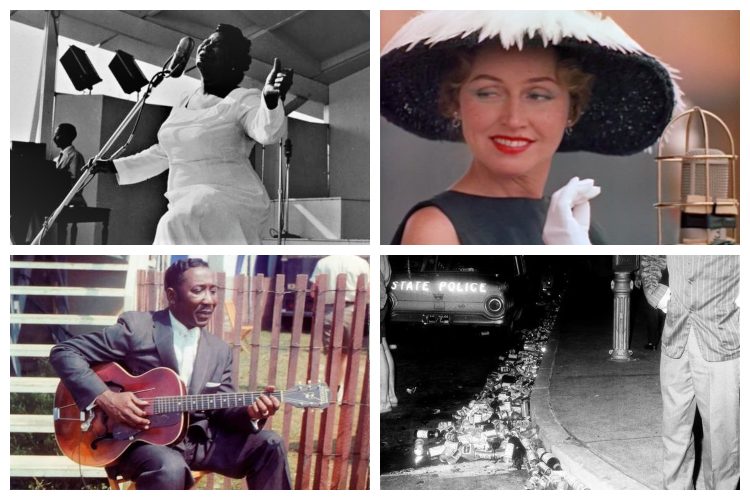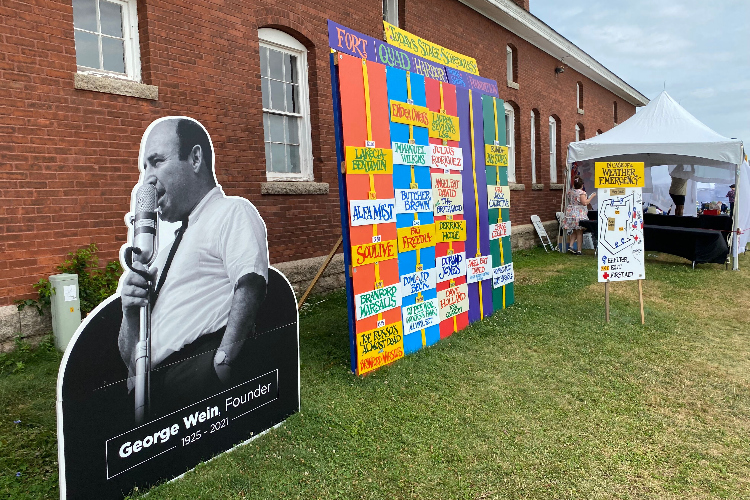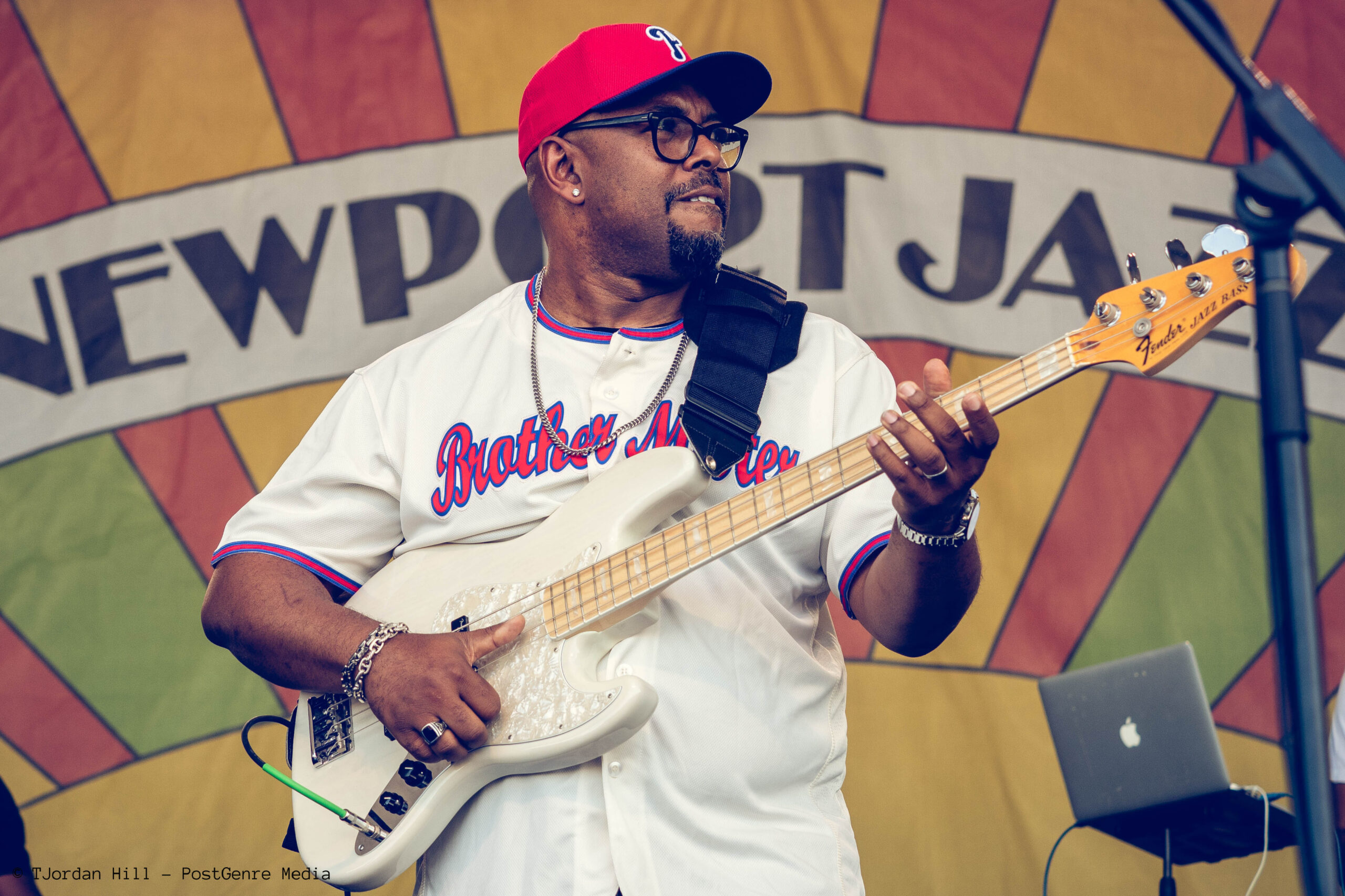A History of the Newport Jazz Festival – Chapter III: Goodbye Newport Blues, 1957-1960
|
Getting your Trinity Audio player ready...
|
The 1957 Festival extended to four days – Thursday, July 4 to Sunday, July 7- with every minute captured by Voice of America. Most were also recorded, though much remains unreleased, by Norman Granz’s Verve Records.
The first evening centered around Louis Armstrong’s purported 57th birthday* with plans to feature many artists who performed with him throughout his career. Ella Fitzgerald, Kid Ory, Cozy Cole, Red Allen, Jack Teagarden, Johnny Mercer, Bobby Henderson, and J.C. Higginbotham would each have their own set. Sidney Bechet was also scheduled but unable to attend. Satchmo would conclude with some duets with Fitzgerald then all of the day’s artists joining him to perform “Happy Birthday” as a cake rolled out, followed by fireworks. However, Armstrong made it clear he never intended to bring the others on stage and abruptly ended the evening. There was significant speculation as to the cause of his anger at the time; it was primarily due to a break down of an understanding between him and his manager Joe Glaser.
The July 5th performances included the Gigi Gryce-Donald Byrd Jazz Laboratory, Toshiko Akiyoshi’s Trio, Cannonball Adderley’s Quintet, Carmen McRae, George Shearing’s Quintet, Stan Getz, Erroll Garner’s Trio, Coleman Hawkins, and the Stan Kenton Orchestra. There were also separate moments with accordionists Leon Sash and Mat Matthews.
The next day boasted Dave Brubeck’s Quartet, the Gerry Mulligan Quartet, Eartha Kitt, and the Dizzy Gillespie Orchestra. Cecil Taylor gave a very early peek into the avant-garde alongside Steve Lacy and Buell Neidlinger. Mary Lou Williams performed for the first time publicly in five years. The Farmingdale (NY) High School Band forged the path for not only the Newport International Youth Band that would tour Europe the following year but also the long history of high school and college bands at the Festival over the ensuing decades. There were also sets by Don Elliott and Eddie Costa. While neither’s name is not well known now, both showed the Festival’s continued interest in pushing boundaries. The former was a calypsonian multi-instrumentalist. The latter, a pianist and vibraphonist who was so skilled at both he became the first to win two instrumental categories in DownBeat’s critics poll. Another mallet player on that day was Lem Winchester, a former cop turned professional musician.
But July 7th brought the year’s most memorable moment. The lineup included more traditional bookings like Teddy Wilson’s Trio, Sarah Vaughn, Oscar Peterson’s Trio, the Count Basie Orchestra, and the Jimmy Giuffre 3 with Jim Hall and Bob Brookmeyer. However, at the insistence of foundation board member John Hammond, the day started with a series of gospel groups. For most in the primarily white audience, it was the first time exposed to the form. The Drinkard Singers (including Whitney Houston’s mom Cissy), the Clara Ward Singers and the Back Home Choir were well received. Following them was the perhaps the greatest singer of the style, Mahalia Jackson, in her first secular appearance. The crowd gave a standing ovation.
The response to Jackson’s performance was so overwhelming that she returned for two days at the 1958 Festival; Thursday, July 3rd, with Duke Ellington’s Orchestra and with a more intimate group at midnight Sunday morning. On the latter, she took the stage at 12:01 AM during the pouring rain. Midway through, the skies miraculously parted and the rain stopped as she sang the old spiritual “Didn’t It Rain.” It became Live at Newport 1958 (Columbia Records, 1958).
1958 was one of the more heavily recorded years. Miles Davis’ performance with his “First Great Quintet”- Cannonball Adderley, John Coltrane, Bill Evans, Paul Chambers, and Jimmy Cobb- would later become At Newport 1958 (Columbia Records, 2001). Horace Silver, Dinah Washington, Duke Ellington’s Orchestra featuring Gerry Mulligan, the Dave Brubeck Quartet, Thelonious Monk, Randy Weston, and Ray Charles all have albums to their name from that festival.
But it was Jazz on a Summer’s Day that was its most prominent artifact. The film, Bert Stern’s only foray into directing, was born when Louis Lorrilard invited him to the year’s proceedings. What started as a short piece quickly became one of the earliest known concert films. Stern himself was an interesting figure with a background in neither film nor music. As an esteemed magazine photographer, he would later make his name for capturing Marilyn Monroe in her final shoot “The Last Sitting.”
His focus on colors and light is apparent throughout Jazz on a Summer’s Day. So is his interest in fashion. Anita O’Day’s white gloves and black hat. Shiny reflections off of Monk’s bamboo sunglasses. Armstrong’s tux in a sea of red light. Texture abounds. And yet, it adds to the ambiance in which the music is presented rather than distract from it.
In his own words, Stern hoped to show “the form and beauty of jazz by the various devices, such as wave and water effects, children playing and reflections.” At times, this makes him step away as some clips are of an America’s Cup race or certain spots in Long Island, New York. But overall the Festival remains at the picture’s essence. It now ranks among the best concert films of all time. In 1999, it was selected for preservation in the Library of Congress’ National Film Registry; an honor only bestowed upon the films that are the most “culturally, historically, or aesthetically significant.”
Intentionally or otherwise, Stern also portrayed the Festival’s continually growing scope. In addition to Sonny Sitt, George Shearing, and Chico Hamilton, one sees not just Mahalia Jackson but also Big Maybelle and the “Father of Rock and Roll” Chuck Berry. The latter two were part of a Saturday night Blues oriented show, again at Hammond’s insistence, as was Ray Charles.
The final year of the 1950s is notorious as a golden period for jazz with the release of many monumental works including The Shape of Jazz to Come (Columbia, 1959), Kind of Blue (Columbia, 1959), Ah Um (Columbia, 1959), Time Out (Columbia, 1959), Moanin’ (Blue Note, 1959), and Jazz in Shilouette (Saturn, 1959). And while this would influence the music of that year’s festival, here were also glimpses of the future. Wayne Shorter made his first appearance at Newport with the Maynard Ferguson Orchestra. It was the first group in which he collaborated with Joe Zawinul with whom he would form Weather Report about a decade later.
But for the Newport Jazz Festival, 1959 was primarily a time of growing tensions. Perhaps foreshadowing the turbulence that marked the coming decade, there was turmoil on three fronts.
First, there was infighting among the Foundation’s board. The Lorillards were in the midst of a divorce and their interpersonal conflicts often overflowed into the business of the board, including Elaine’s ouster from management and the threats of related lawsuits.
There was also a growing tension with members of the press, many of whom were becoming weary of the Festival’s expansiveness. Initial plans to plug into the burgeoning folk revival by scheduling an afternoon dedicated to the style by booking Pat Suzuki, the Kingston Trio, and the Four Freshman, were met with fervent allegations of crass commercialism. It appeared to some that the Festival’s goals of increased inclusion had gone one step too far. In part to minimize criticism, the programming block changed into a separate event; The Newport Folk Festival.

Perhaps most problematic was the straining relationship between the Festival and the city of Newport. During the Festival week, many bars would stay open all night, seldom checking for any identification or corralling the increasing population of drunken visitors. Many young people would sleep on public beaches, in parks, or anywhere else they could find. Security at the festival kept these problems from entering Freebody Park and interrupting artists like Kenny Burrell, Ahmad Jamal, Sir John Dankworth, Herbie Mann, and Charles Mingus. But the island was increasingly descending into chaos.

All three of these problems would ultimately guide the infamous 1960 Festival. Critics, particularly Nat Hentoff, increasingly accused the Festival of not just commercialism but racism. Charles Mingus agreed and along with Hentoff and a scorned Elaine Lorillard hosted a counter-festival at the Cliff Walk Manor overlooking First Beach. With Max Roach, Ornette Coleman, Eric Dolphy, Jo Jones, Arthur Taylor, Kenny Dorham, Wilbur Ware, Kenny Drew, and Coleman Hawkins, the Newport Rebels Festival was born. It was also scheduled the same weekend as the Newport Jazz Festival, Thursday, June 30 through Monday, July 4.

Like its younger counterpart, the elder Festival planned a fantastic lineup. There are some truly notable selections among the already stellar “regulars” like the Louis Armstrong All-Stars, Dave Brubeck, and the Dizzy Gillespie Quintet. Ray Charles, would appear, a year after his “What’d I Say” shook the nation. John Coltrane was scheduled with his quartet, fresh off of the release of Giant Steps (Atlantic, 1960). A group called the Nashville All-Stars featuring legendary guitarists Hank Garland and Chet Atkins was to perform with a teenaged Gary Burton.
By Saturday night, a swarm of drunk teenagers and coeds attempted to join Wein’s sold-out event and, began attacking when local police denied their entry. This gradually turned into a riot. The governor directed state troopers and the National Guard to the area. Inside Freebody Park, Horace Silver’s Quintet with trumpeter Blue Mitchell, tenor saxophonist Junior Cook, bassist Gene Taylor, and drummer Roy Brooks transfixed an audience as they delivered energized and heavy-hitting songs from their recent Blowin’ the Blues Away (Blue Note, 1959) including the classic “Sister Sadie.” It was a welcome distraction from the scene outside of the venue’s stone walls where streets were littered with flipped cars, broken glass, and the smell of tear gas.



The next morning, the Newport City Council held an emergency meeting to respond to the situation, ultimately voting 4-3 in favor of revoking the Foundation’s entertainment license. The council allowed the Festival only one last moment to express itself, its Sunday afternoon show dedicated to the blues. Now called “Goodbye Newport Blues” poet Langston Hughes narrated a two-hour journey through the structure and backstory of the form featuring Muddy Waters, Otis Spann, James Cotton, John Lee Hooker, and Jimmy Rushing. At the end, Willis Conover, the festival’s emcee made an announcement:
“[T]here will be no concert tonight or…again… The board of directors deeply regret that the true jazz lovers were denied the opportunity to hear their favorite jazz musicians, due entirely to non-ticket holding outside the park. I think it’s a shame that the Newport Jazz Festival has to be killed because a bunch of pseudo beatniks and rock ‘n’ roll escapees who had no interest in jazz, had no intention of coming to the concerts and were not inside the park at all, decided to use the Newport Jazz Festival weekend and the City of Newport as an excuse for giving vent to their healthy animal instincts in such a fashion as to qualify them for admission to a zoo rather than a school. It does seem to me that in attempting to cure the disease that infected the Newport Jazz Festival activities, they decided to shoot the patient without clearing up the germs.”
The Newport Jazz Festival was dead.
They are also available on demand.
The Ray Charles and Cannonball Adderley Quintet sets from the 1960 festival will be broadcast by WBGO on Friday July 31st at 11PM EST and Saturday, August 1st at 6PM EST as part of Christian McBride’s Jazz Night in America.
They too are available on demand.
Significant portions of this chapter were adapted from George Wein’s autobiography (written with Nate Chinen) ‘Myself Among Others’ (Da Capo Press, 2004), and ‘50: The Newport Jazz Festival, 1954-2004’, and ‘What a Wonderful World, The Magic of Louis Armstrong’s Later Years’ by Ricky Riccardi (Pantheon, 2011).
A 4K restored version of ‘Jazz on a Summers’ Day’ will be available online on August 12, 2020
In our store, you can also find Ricky Riccardi’s ‘What a Wonderful World, The Magic of Louis Armstrong’s Later Years’ by Ricky Riccardi (Pantheon, 2011).
*Armstrong often claimed he was born on July 4, 1900. The current general consensus, however, is that his actual birth date was 13 months later: August 4, 1901.



